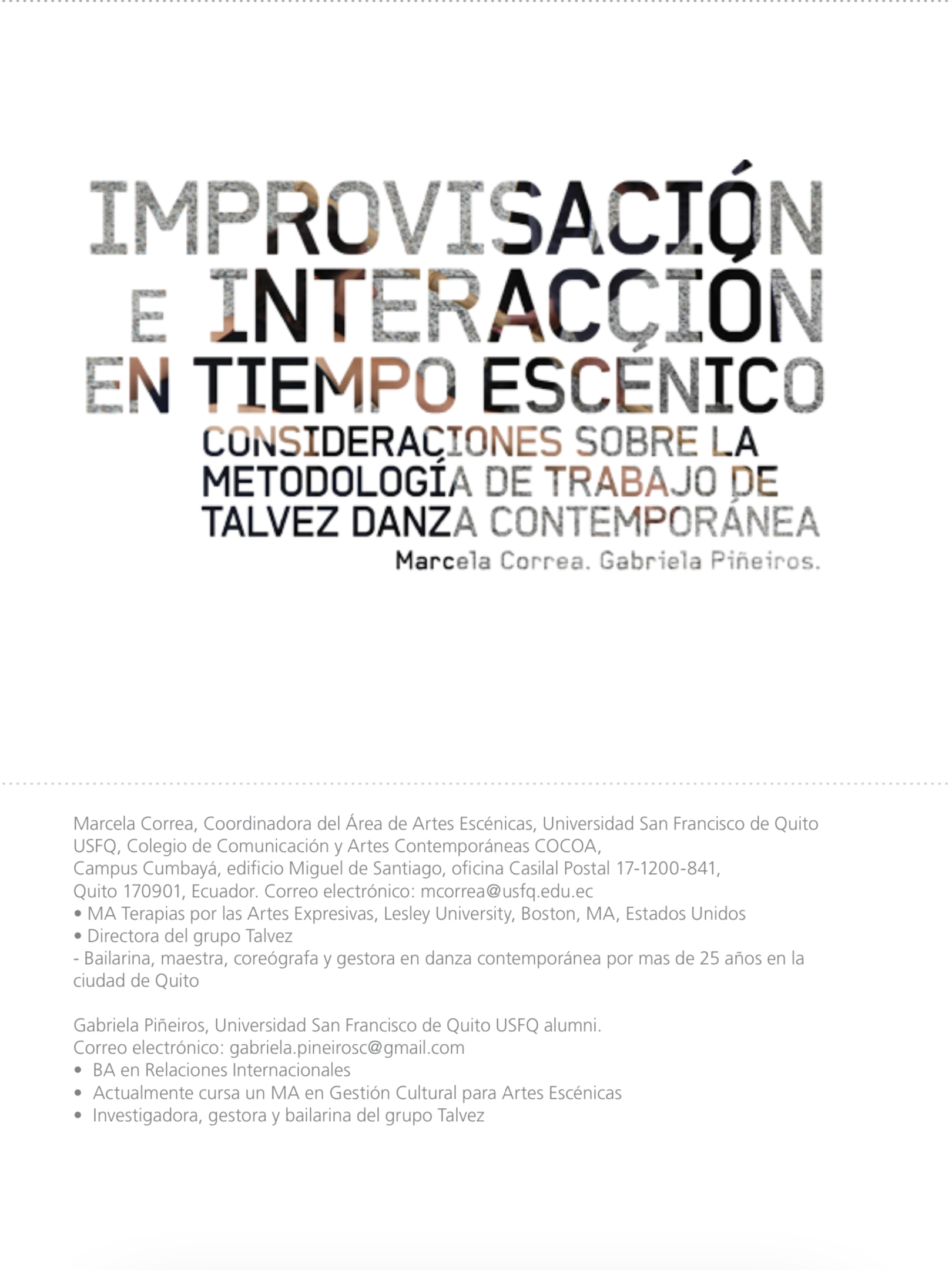Improvisation and interaction in scenic time. Considerations on the methodology of Talvez Danza Contemporánea

Published 2017-11-01
Keywords
- Dance,
- spectator,
- actor,
- participation
How to Cite
Copyright (c) 2017 Marcela Correa, Gabriela Piñeiros

This work is licensed under a Creative Commons Attribution-NonCommercial 4.0 International License.
Abstract
This essay seeks to contextualize the work of the dance company Talvez Danza Contemporánea, founded in the College of Communication and Contemporary Arts of the University San Francisco de Quito in 2008. The essay is divided into three parts; the first establishes a dialogue with thinkers of the contemporary such as Derrida and Baumann, to demonstrate the necessity of breaking static structures in the art in order to develop flexible, open and unstable proposals. The second traces a historical reference to the construction of classical theater, the way it divided the relation actor-viewer and the possibilities of connection and learning that can be created with the public when we provoke a rupture with the classical forms. Finally, the third entry analyses the method proposed by Talvez.
Downloads
References
- Bauman, Z. (2000). Modernidad líquida. Buenos Aires: Fondo de Cultura Económica de Argentina.
- Bauman, Z. (2007). Miedo líquido. La sociedad contemporánea y sus temores. Barcelona: Paidós.
- Bergson, H. (2015). Time and free will. An Essay on the Immediate Data of Consciousness. Mans-field: Martino Publishing.
- Bernat, R. (2016). Entrevista en el marco de su residencia con ERRO Grupo en Florianápolis. Re-cuperada de https://www.youtube.com/ watch?v=VStChS102v8
- Blom, L. A. y Chaplin, L. T. (1988). The Moment of Movement. Londres: Dance Books.
- Bogart, A. y Landan, T. (2005). The Viewpoints Group. Nueva York: Theater Communications Group.
- Burt, R. (2011). [Ramsay Burt]. (2011, abril 17). Reflexions on Steve Paxton"™s Magnesium. Recuperado de https://vimeo.com/22515367
- Chodorow, J. (1991). Dance Therapy and Depth Psycology. Nuevo York: Rouledge.
- Forsythe, W. y Sulcas, R. (autor). (2010). William Forsythe, Improvisation Technologies. Karlsruhe: Kahrlsruhe Editors.
- Fratini, R., Bernat, R. [Festival 10 sentidos]. (2014, 12, 12). Conferencia con Roger Bernat y Roberto Fratini - V Festival 10 Sentidos. Recuperado de https://www.youtube.com/ watch?v=t09wo3fuHwU
- Fratini, R. (2015, 15 de junio). Llindars de la inacció: nous estatuts i velles paradoxes del teatre de participació. Barcelona: Agost Producciones. Recuperado de http://agostproduccions.com/blog/wp-content/uploads/2016/03/Nous- estatuts-i-velles-paradoxes-del-teatre-de-participacio_Roberto-Fratini.pdf
- Garcés, M. (2009). Visión periférica. Ojos para un mundo común. En Ana Buitrago, ed., Arquitecturas de la mirada (pp. 77-96). Madrid, España: Universidad de Alcalá de Henares.
- Laban, R. (author), Ullmann, L. (editor). (2011). The Mastery of Movement. Dance Books Limited. Binsted: Dance Books Limited.
- Lepécki, A. (2012). Dance. Londres: Whitechapel Gallery.
- Maning, E. (2007). The Politics of Touch. Minnesota: University of Minnesota Press.
- Niranjanananda, W. (2009). Prana and Pranayama. Nueva Delhi: Thomason Press Limited.
- Pállaro, P. (1999). Authentic Movement. Londres: Jessica Kingsley Publishers.
- Pérez Royo, V. (2007, primavera). Espacio escénico y las tecnologías interactivas. Artea.
- Royle, N. (2003). Jacques Derrida. Londres: Routledge.
- Spoling, V. (1999). Improvisation for the Theater. Evanson: Northwestern University Press.
- Stanislavsky, C. (1964). An Actor Prepares. New York: routledge.
- Vivekananda, R. (2005). Practical Yoga Psychology. Mungar: Yoga Publications Trust.
- White, G. (2013). Audience participation in theater. Londres: Palgrave Mcmillan.
